The MMS mission is a major scientific undertaking, involving a number of institutions in the United States as well as partners in Europe and Japan. The four spacecraft are being built, integrated, and tested at NASA’s Goddard Space Flight Center, Greenbelt, Maryland, which is also responsible for mission operations. Science operations planning and instrument command sequence development will be performed at the MMS Science Operations Center (SOC) located at the University of Colorado’s Laboratory for Atmospheric and Space Physics, Boulder, Colorado. The MMS Science Team is led by Southwest Research Institute, San Antonio, Texas, and consists of an Instrument Team and a Theory and Modeling Team. In addition, NASA has selected three interdisciplinary Science (IDS) teams to participate in the mission as members of the MMS Science Working Group.
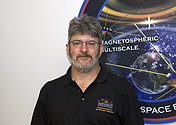 |
Craig Tooley MMS Project Manager Mr. Tooley is currently the project manager for NASA's Magnetospheric Multiscale (MMS) mission. MMS is an in-house GSFC mission launching in March of 2015, which will use four identical spacecraft, flown in formation in Earth orbit, to make three-dimensional measurements of the plasma in the magnetospheric boundary regions and investigate the fundamental energy transfer process of magnetic reconnection. Mr. Tooley joined the MMS Team as Project Manager in May 2011. Prior to being assigned as the MMS project manager Mr. Tooley was NASA's project manager for the Joint Polar Satellite System (JPSS) Flight Project. The JPSS Flight Project is responsible for providing the nation's next generation of polar orbiting weather and climate science satellites in partnership with the National Oceanic and Atmospheric Administration (NOAA). Before joining JPSS Mr. Tooley was the project manager for the Lunar Reconnaissance Orbiter (LRO) mission at NASA's Goddard Space Flight Center (GSFC). He was responsible for the development and execution of the LRO mission for NASA's Exploration Systems Mission Directorate (ESMD). LRO was developed in-house at NASA's Goddard Space Flight Center, was launched on June 18th, 2009, and is successfully operating in lunar orbit. Previously, Mr. Tooley was the Head of the Hubble Space Telescope (HST) Instrument Development Office at GSFC. In this capacity oversaw the development of instruments that were installed in the HST during the 4th HST servicing Mission. During his tenure in the HST Project Mr. Tooley also worked as part of the EVA Servicing Team, which developed procedures and trained astronauts for the successful SM3B servicing mission in 2002. Prior to working in the HST Project Mr. Tooley served as the Deputy Project Manager for the Triana Project. Triana was a Space Shuttle launched earth science mission which was to provide continuous global observation from a libration point (L1). Mr. Tooley also directly lead the engineering development of the upper stage and Space Shuttle Airborne Support Equipment required for the Triana mission. Triana (now renamed DSCOVR) was built and fully qualified at GSFC but has not yet been launched. During his career at GSFC Mr. Tooley has served as the Mission Manager and Mechanical Engineering Lead for 5 successful Shuttle borne, solar science Spartan missions and held the position of Associate Branch Head of the Carrier Systems Branch. During the first part of his career he worked as an engineer the Mechanical, Attitude Control and Stabilization, and the Mission Analysis groups at GSFC. Mr. Tooley has been employed by NASA since 1983 and has a background in Mechanical Engineering. He earned a BS in Mechanical Engineering from the University of Evansville and a MS in Mechanical Engineering from the University of Maryland. He holds a Senior-Expert level of Project Management certification at NASA. |
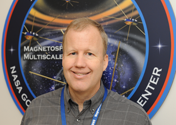 |
Brent Robertson MMS Deputy Project Manager Brent Robertson has been the Deputy Project Manager for the Magnetospheric Multiscale (MMS) mission since 2008. From 2003 through 2008, Mr. Robertson was the Observatory Manager for the Solar Dynamics Observatory, where he was responsible for management of the GSFC in-house built spacecraft. From 2002 through 2003, he was the Associate Division Chief for the Guidance, Navigation and Control (GN&C) Division. From 1997 through 2002, he was the Branch Head for the GN&C Systems Engineering Branch. From 1994 through 1997, Mr. Robertson held multiple positions as a Lead Engineer, Group Lead, and Section Head in the GN&C Systems Branch. He was the Lead Engineer for the Hubble Space Telescope Hemispherical Resonator Gyro technology upgrade effort, the Attitude Contol System (ACS) Lead Engineer for Total Ozone Mapping Spectrometer - Explorer Platform (TOMS-EP), and the ACS Lead Engineer for the Tropical Rainfall Measuring Mission (TRMM), a GSFC in-house-built spacecraft. Prior to joining NASA, from 1989 through 1994 Mr. Robertson was a Systems Engineer and Control Systems Manager for McDonnell Douglas, supporting various NASA GSFC Flight Projects including the Earth Observing System (EOS) and the Geostationary Operational Environmental Satellites (GOES). From 1985 through 1989, Mr. Robertson was a Systems Engineer for Analytical Mechanics Associates, supporting the NASA LaRC Space Systems Engineering and Integration Office and NASA LaRC Space Station Freedom Office. Mr. Robertson received a BS in Engineering Science at the University of Toronto, and a MS in Aerospace Engineering from the University of Virginia. Mr. Robertson has received the NASA Medal for Exceptional Service and numerous achievement and performance awards. |
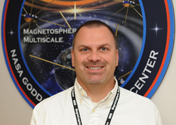 |
William Sluder MMS Deputy Project Manager/Resources Mr. Sluder joined NASA at Goddard Space Flight Center in 1990 as a Resources Analyst on the International Solar Terrestrial Physics Project, working on the SOHO, CLUSTER and GEOTAIL missions. Since then he has held positions of increasing responsibility and authority as a Resources Analyst and Financial Manager on the Hubble Space Telescope Operations and Grounds System Project, Program Analyst in GSFC’s office of the Chief Financial Officer, Financial Manager on the Landsat Data Continuity Mission, and Financial Manager and Deputy Project Manager for Resources on the Lunar Reconnaissance Orbiter Project. He helped establish the Robotics Lunar Exploration Program office and the LRO project office and remained a member of the LRO team until after the commissioning phase was complete. Currently, Mr. Sluder serves as the Deputy Project Manager for Resources on the Magnetospheric Multiscale Project. Mr. Sluder has been recognized as a key figure for managing in-house flight projects at Goddard and for helping to establish an earned value management system that is the basis for EVM systems used on several other projects at Goddard. During his time at Goddard, Mr. Sluder has earned numerous group and individual awards, including the NASA Exceptional Achievement Medal in 2010. |
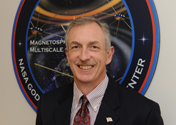 |
Peter Spidaliere MMS Mission System Engineering Mr. Spidaliere joined GSFC in 1989 as the Systems Engineer for the Flight Telerobotic Servicer. He later became the Systems Engineer for the First Hubble Space Telescope Servicing Mission and in 1994 became the Spacecraft Systems Engineer for Landsat 7. He then transferred to the Johnson Space Center (JSC) to serve as the Systems Engineering Manager for the International Space Station (ISS). In 1996 he became the Deputy Project Manager for the ISS Interim Control Module at the Naval Research Laboratory. Mr. Spidaliere returned to GSFC in 1997 to serve as the Mission Systems Engineer for the Earth Observing-1 Mission, later returning to JSC in 1999 to join the Space Shuttle Upgrades Program. In 2001 he became the JSC Chief Engineer and Systems Engineering Manager for the Orbital Space Plane Program. After the Shuttle Columbia disaster he volunteered to lead the Shuttle Orbiter Thermal Protection System safety team. During this time he developed an on-orbit infrared sensor technique to detect damage to the Orbiter’s wing leading edge. In 2005 he returned to GSFC again to support the Exploration Program at Headquarters. He has been the Mission Systems Engineer for the Magnetospheric Multi-Scale Project since 2005. Mr. Spidaliere received his B.S. in Mechanical Engineering at Virginia Tech in 1983. Prior to joining GSFC worked in Industry and for the Navy in the robotics field. |
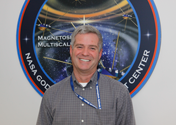 |
John Blackwood MMS Chief Safety and Mission Assurance Officer John Blackwood is the Chief Safety and Mission Assurance Officer (CSO) for the MMS Project at the NASA Goddard Space Flight Center. He began his work at Goddard in 1990 as a Performance Assurance Engineer in Code 300. In that capacity, he supported the Spartan, GAS, Hitchhiker, and Earth Observing System projects. In 1996 John transferred to the Materials Engineering Branch (Code 541) where he served as a Materials Engineer for over 10 years. During this time he led the effort to develop a laser interferometer system to support the James Webb Space Telescope development. This system is capable of measuring coefficient of thermal expansion (CTE) to a precision level that was unparalleled at NASA. John also led the development of the scanning Kelvin Probe which is used to determine surface morphology or the composition and electronic state of the local structures on the surface of a solid. This technology was needed for the Laser Interferometer Space Antenna (LISA) project and likewise represented a new technology and capability to NASA. While in the Materials Engineering Branch, his responsibilities also included such things as engineering problem resolution, lab management and group leader for the Materials Analysis and Technology Group. In 2006 John returned to Code 300 to serve as the CSO and an independent technical authority for the MMS project. |
 |
Dr. Thomas Moore MMS Project Scientist Thomas E. Moore earned the B.S. in Physics in 1970, and the M.A. in 1971, from the University of New Hampshire. He received the Ph.D. in Astrogeophysics from the University of Colorado, Boulder in 1978. Returning to UNH, he worked on the dynamics of the plasma environment at geosynchronous orbit. He also was active in the observation of plasma and energetic particles above auroral displays from sounding rocket platforms. Dr. Moore joined NASA at Marshall Space Flight Center in 1983 as a member of the science team for the Retarding Ion Mass Spectrometer on the Dynamics Explorer-1 Satellite. He supplied plasma spectrometers for the TOpside Probe of the Auroral Zone (TOPAZ) series of sounding rocket payloads, the ARCS series of active experiment payloads, and the SCIFER and CAPER cusp payloads. At MSFC, he became the principal investigator for the Thermal Ion Dynamics Experiment and Plasma Source Instrument for the ISTP POLAR spacecraft. Dr. Moore joined the Goddard Space Flight Center in May 1997, to serve as project scientist for the IMAGE mission, as lead co-investigator for the Low Energy Neutral Atom imager on IMAGE, and to pursue broader interests in heliospheric and planetary plasma heating and outflow. He is an American Geophysical Union Fellow, having served as awards committee member, section secretary, and program committee member for the Space Physics and Aeronomy section. He served as a member of the Solar Probe science definition team, The Sun Earth Connections Advisory Subcommittee, as a co-chair of the first NASA “Heliophysics” Roadmap Committee, and as study scientist for the Magnetotail Constellation Mission. He is a co-investigator on the Interstellar Boundary Explorer mission, and on the Magnetospheric Multi-Scale mission, for which he was recently appointed project scientist. |